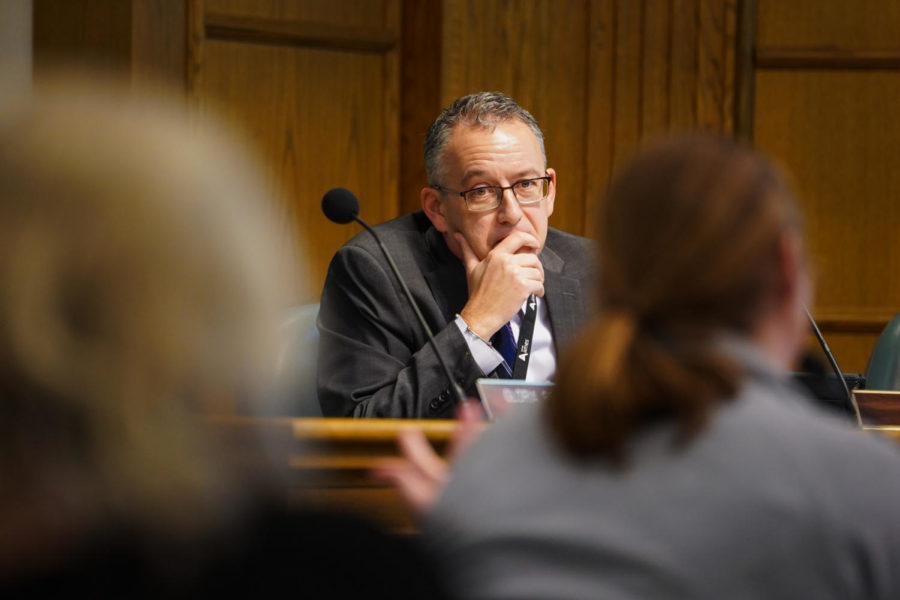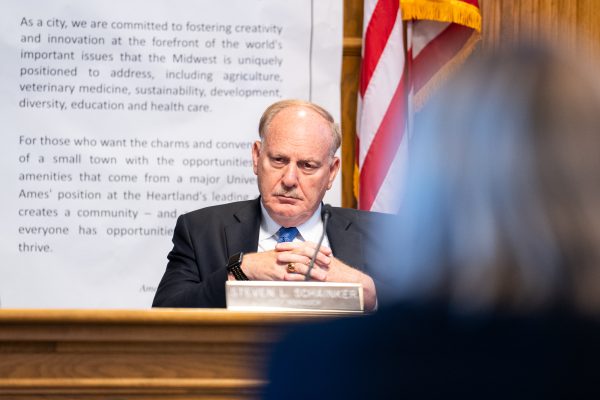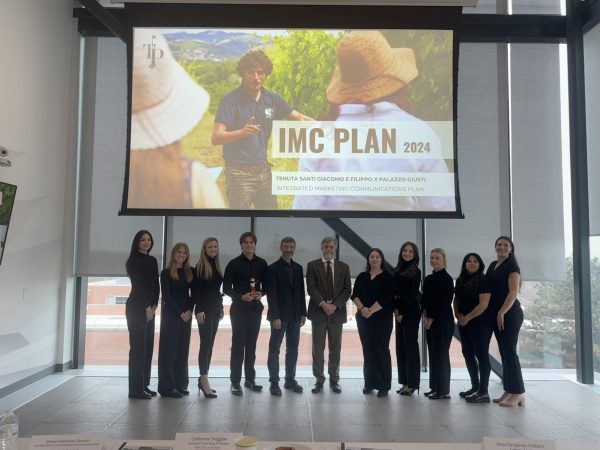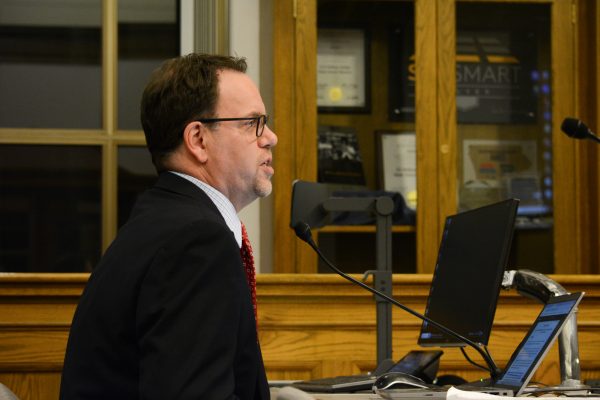Ames City Council Reviews Bicycle and Pedestrian Master Plan
Ward 2 Rep. Tim Gartin listens to a presentation on Jan. 24.
The Ames City Council reviewed recent survey results showing that Ames residents do not feel safe with current bike lane conditions.
The survey, conducted by the city, is in conjunction with the Bicycle and Pedestrian Master Plan which aims to make multimodal forms of transportation more viable and safe across Ames. However, council members found that the data largely missed Iowa State students and underrepresented ethnic groups.
Public Input to Date
Major demographics were underrepresented in the city survey, which had less than 400 responses. Compared to the Ames population, the survey was proportionally under-representative of Asian, Hispanic and Black residents, and significantly underrepresented people between the ages of 18 to 24.
Ward 1 Rep. Gloria Betcher said the survey showed nearly no Iowa State student participation.
The participation among students was quite low, and the survey link was shared among various student clubs to distribute to their members said Adam Wood, senior planner for Toole Design Group. However, the city did set up a table at the sustainability fair at Iowa State and spoke to around 40 people, but they were only asked their opinion and vision of biking and walking in Ames.
Ward 2 Rep. Tim Gartin said he was concerned about the lack of data surrounding K-12 students and suggested they go to the parent-teacher associations throughout Ames’ schools to gain more feedback.
“It would be helpful to know for a certain school, do parents think they have safe routes to school and if they have suggestions,” Gartin said. “If we want this to be safe, I think we want to hear from parents, specifically around the schools.”
The council was concerned about the data, which Wood said was within 10% of the nationwide average. The survey showed more than half of the bikers in Ames do not feel comfortable with the current bike lanes. Many bikers would utilize the sidewalks even if bike lanes were available, according to the survey. The survey also demonstrated that respondents want more places to bike, and safer places to cross streets.
Public Feedback
The council received public feedback on revision of the vision of the plan: “Ames is a place where walking, biking, and rolling is safe, comfortable, enjoyable, convenient and available to everyone — regardless of age, ability, identity, race or economic status.”
Betcher, who is also an English professor at Iowa State, had some grammatical concerns about the revised vision.
“I got hung up on the ‘is safe’ because walking, biking and rolling is a compound subject, which means there are multiple modes and it’s a singular verb,” Betcher said. “It drives me nuts to see that — shouldn’t it be ‘are safe?’”
Ward 3 Rep. Anita Rollins said she felt like the “regardless” statement was not necessary.
“Sometimes those kinds of words show some intentionality, about, we know when we say everyone, we really mean everyone,” Rollins said.
At-large Rep. Amber Corrieri agreed with Gartin that the statement was not unique to Ames. Gartin said the vision statement is fairly general and asked if any town in America would not agree with it.
The council is still looking for feedback on the plan, which can be sent to: [email protected].
Existing Conditions
Wood identified concerns with potential ordinances that may be in conflict with the plan, which included altering a ban on bikes on Grand Avenue and removing fines for carrying items or riding on sidewalks next to busy streets.
Mayor John Haila said the sidewalk graphics from Toole Design showed what it labeled as missing or incomplete sidewalks that were outside of Story County and the city limits. He subsequently questioned how data from StreetLight was collected, which showed where bike trips begin and end in Ames.
“StreetLight uses all sorts of data sources including traces on Bluetooth devices and so forth to see the paths people are taking when they travel,” Wood said.
Gartin said if that data is true, he finds it interesting that the South Grand business districts are showing so much bike traffic.
“It’s sorta terrifying for me from the standpoint that South Duff is one of the worst places to bike in the community,” Gartin said.
Betcher guessed that the bike traffic was likely from apartments in the area, however, Haila said it is very rare he sees a bike out in the southwest industrial area of Ames.
Using an activity-based travel model from Replica, a data consultant, Wood presented statistics on the method of transportation people used for trips under 1 mile and trips between 0.25-1 mile.
For trips under 1 mile, the data showed less than 3% of trips were public transit and 4% for trips between 0.25-1 mile.
“The orange route on CyRide is the most heavily used in the state for public transit,” Haila said. “How can they gauge public transit when you have so many students getting on and off the bus on campus?”
Wood responded saying Replica does not have ways to distinguish between a transit, walking or biking trip.
“I question the validity of that one because take 4% of 228,000 and that’s less than 10,000, and I think that there’s well over 10,000 riders on public transit on just one route,” Haila said.
Wood clarified with Haila that the data is just for trips under a mile, but Haila said some trips for students on campus are just a block. Ultimately, Wood said the goal of this model is to determine the scale of driving that is occurring per day, which was 45% for trips between a quarter mile and one mile.
“I know a lot of people who drive a short distance to park to take the orange route, and so I wonder how many of that 45% are people who then switch to public transit,” Betcher said.
Your donation will support the student journalists of the Iowa State Daily. Your contribution will allow us to purchase equipment, send our student journalists to conferences and off-set their cost of living so they can continue to do best-in-the-nation work at the Iowa State Daily.











Mark goodale | Feb 1, 2023 at 6:37 pm
Wouldn’t we be better using our financial resources by just putting sidewalks on both sides of the street “everywhere” in city limits? Instead of wasting our money and time on surveys? We need sidewalks everywhere we have streets!!! This is not rocket science. This is personal safety.